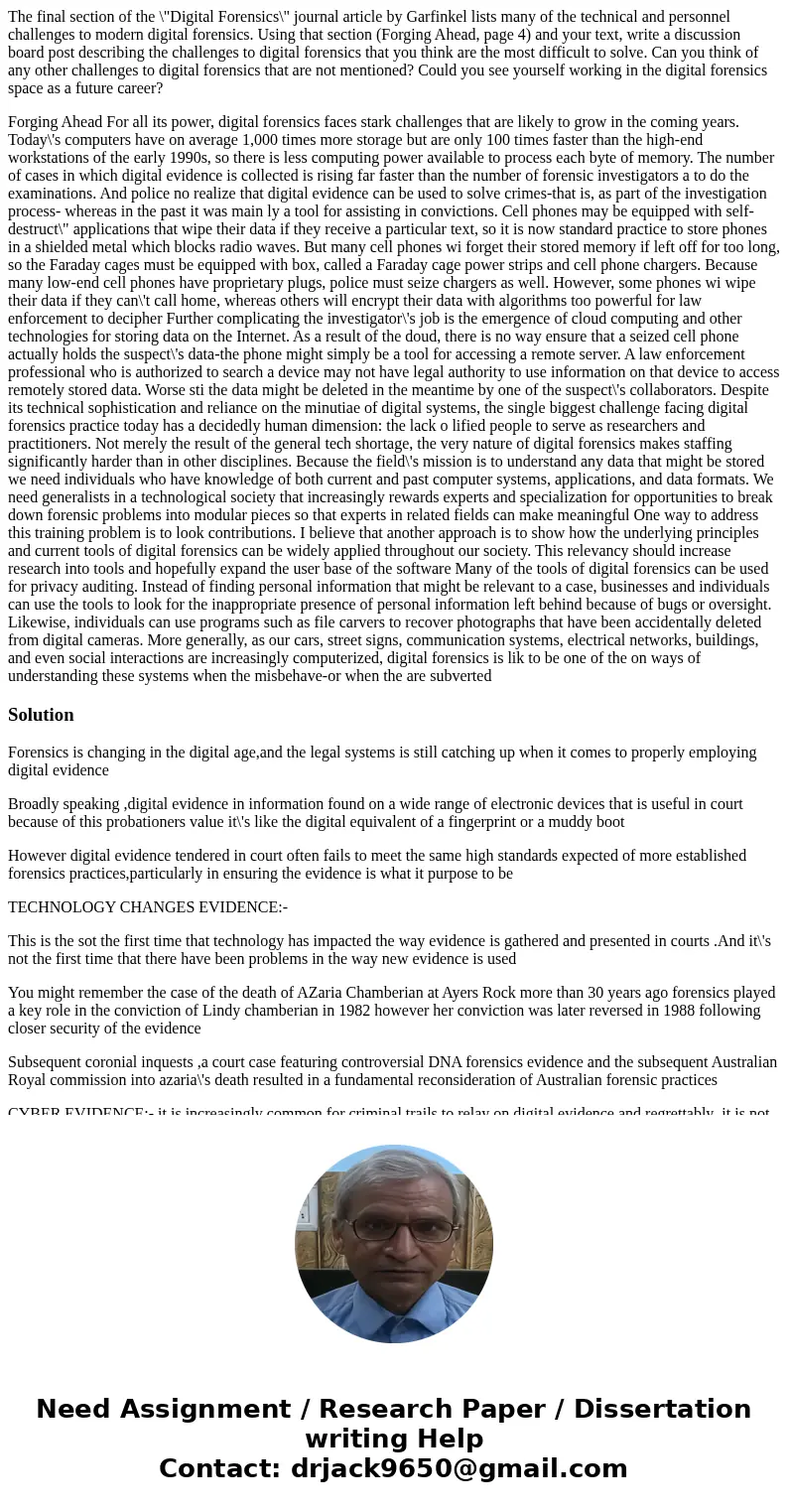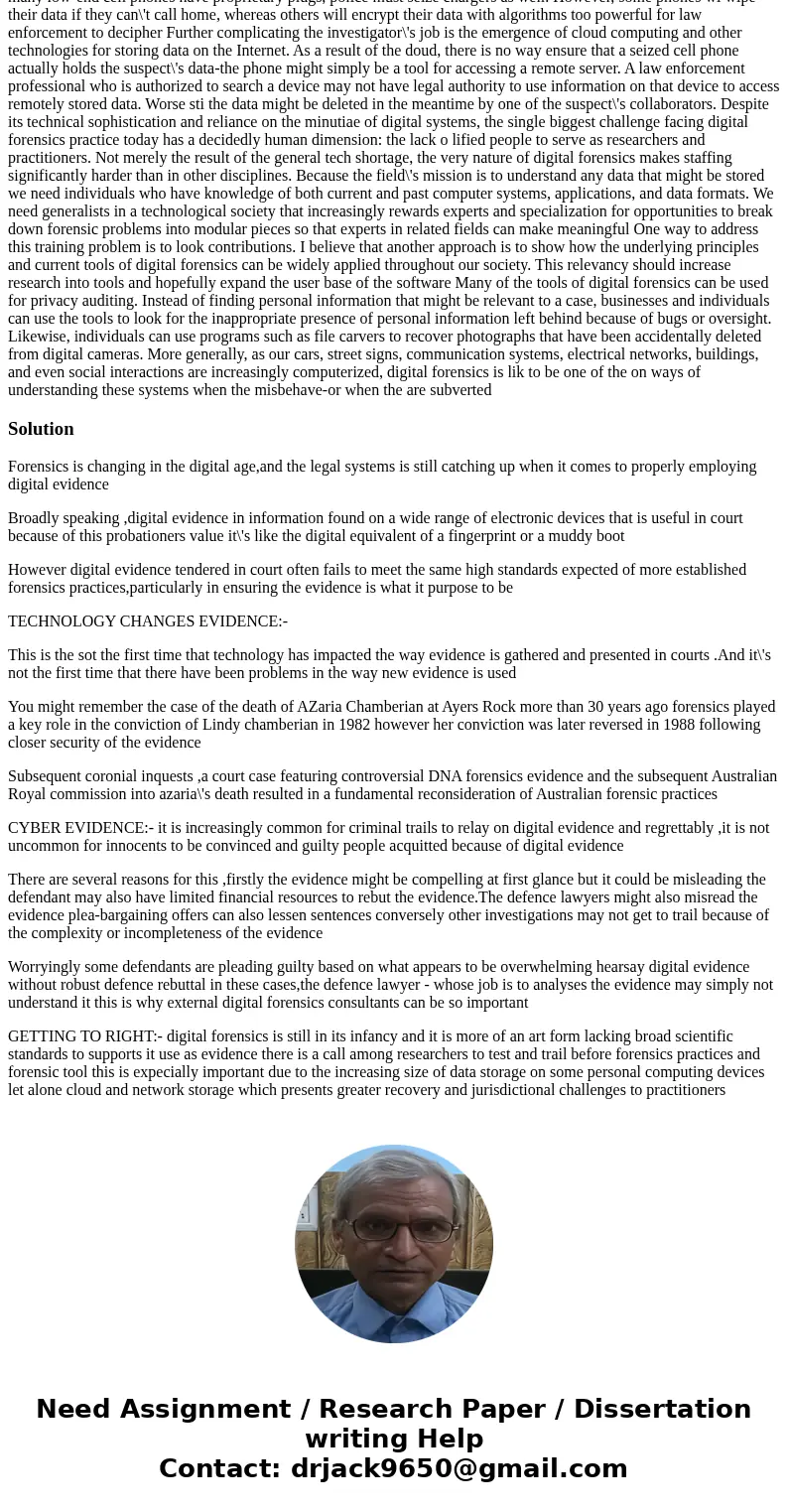The final section of the Digital Forensics journal article b
The final section of the \"Digital Forensics\" journal article by Garfinkel lists many of the technical and personnel challenges to modern digital forensics. Using that section (Forging Ahead, page 4) and your text, write a discussion board post describing the challenges to digital forensics that you think are the most difficult to solve. Can you think of any other challenges to digital forensics that are not mentioned? Could you see yourself working in the digital forensics space as a future career?
Forging Ahead For all its power, digital forensics faces stark challenges that are likely to grow in the coming years. Today\'s computers have on average 1,000 times more storage but are only 100 times faster than the high-end workstations of the early 1990s, so there is less computing power available to process each byte of memory. The number of cases in which digital evidence is collected is rising far faster than the number of forensic investigators a to do the examinations. And police no realize that digital evidence can be used to solve crimes-that is, as part of the investigation process- whereas in the past it was main ly a tool for assisting in convictions. Cell phones may be equipped with self-destruct\" applications that wipe their data if they receive a particular text, so it is now standard practice to store phones in a shielded metal which blocks radio waves. But many cell phones wi forget their stored memory if left off for too long, so the Faraday cages must be equipped with box, called a Faraday cage power strips and cell phone chargers. Because many low-end cell phones have proprietary plugs, police must seize chargers as well. However, some phones wi wipe their data if they can\'t call home, whereas others will encrypt their data with algorithms too powerful for law enforcement to decipher Further complicating the investigator\'s job is the emergence of cloud computing and other technologies for storing data on the Internet. As a result of the doud, there is no way ensure that a seized cell phone actually holds the suspect\'s data-the phone might simply be a tool for accessing a remote server. A law enforcement professional who is authorized to search a device may not have legal authority to use information on that device to access remotely stored data. Worse sti the data might be deleted in the meantime by one of the suspect\'s collaborators. Despite its technical sophistication and reliance on the minutiae of digital systems, the single biggest challenge facing digital forensics practice today has a decidedly human dimension: the lack o lified people to serve as researchers and practitioners. Not merely the result of the general tech shortage, the very nature of digital forensics makes staffing significantly harder than in other disciplines. Because the field\'s mission is to understand any data that might be stored we need individuals who have knowledge of both current and past computer systems, applications, and data formats. We need generalists in a technological society that increasingly rewards experts and specialization for opportunities to break down forensic problems into modular pieces so that experts in related fields can make meaningful One way to address this training problem is to look contributions. I believe that another approach is to show how the underlying principles and current tools of digital forensics can be widely applied throughout our society. This relevancy should increase research into tools and hopefully expand the user base of the software Many of the tools of digital forensics can be used for privacy auditing. Instead of finding personal information that might be relevant to a case, businesses and individuals can use the tools to look for the inappropriate presence of personal information left behind because of bugs or oversight. Likewise, individuals can use programs such as file carvers to recover photographs that have been accidentally deleted from digital cameras. More generally, as our cars, street signs, communication systems, electrical networks, buildings, and even social interactions are increasingly computerized, digital forensics is lik to be one of the on ways of understanding these systems when the misbehave-or when the are subvertedSolution
Forensics is changing in the digital age,and the legal systems is still catching up when it comes to properly employing digital evidence
Broadly speaking ,digital evidence in information found on a wide range of electronic devices that is useful in court because of this probationers value it\'s like the digital equivalent of a fingerprint or a muddy boot
However digital evidence tendered in court often fails to meet the same high standards expected of more established forensics practices,particularly in ensuring the evidence is what it purpose to be
TECHNOLOGY CHANGES EVIDENCE:-
This is the sot the first time that technology has impacted the way evidence is gathered and presented in courts .And it\'s not the first time that there have been problems in the way new evidence is used
You might remember the case of the death of AZaria Chamberian at Ayers Rock more than 30 years ago forensics played a key role in the conviction of Lindy chamberian in 1982 however her conviction was later reversed in 1988 following closer security of the evidence
Subsequent coronial inquests ,a court case featuring controversial DNA forensics evidence and the subsequent Australian Royal commission into azaria\'s death resulted in a fundamental reconsideration of Australian forensic practices
CYBER EVIDENCE:- it is increasingly common for criminal trails to relay on digital evidence and regrettably ,it is not uncommon for innocents to be convinced and guilty people acquitted because of digital evidence
There are several reasons for this ,firstly the evidence might be compelling at first glance but it could be misleading the defendant may also have limited financial resources to rebut the evidence.The defence lawyers might also misread the evidence plea-bargaining offers can also lessen sentences conversely other investigations may not get to trail because of the complexity or incompleteness of the evidence
Worryingly some defendants are pleading guilty based on what appears to be overwhelming hearsay digital evidence without robust defence rebuttal in these cases,the defence lawyer - whose job is to analyses the evidence may simply not understand it this is why external digital forensics consultants can be so important
GETTING TO RIGHT:- digital forensics is still in its infancy and it is more of an art form lacking broad scientific standards to supports it use as evidence there is a call among researchers to test and trail before forensics practices and forensic tool this is expecially important due to the increasing size of data storage on some personal computing devices let alone cloud and network storage which presents greater recovery and jurisdictional challenges to practitioners


 Homework Sourse
Homework Sourse